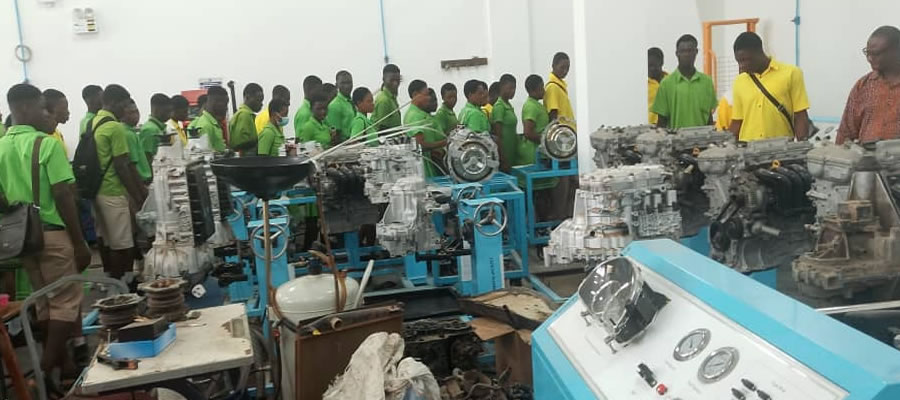

TRADITIONAL SOCIETY AND CULTURE
Family Structures
Family structure is basically the same as in other groups in northern Ghana. It is patrilineal but weakened by a greater amount of independence for women in the household. Because the bride price is low initially (a few gifts) men marry easily, but it is harder to keep a wife than it is to marry one. If a couple remains together, the husband is required to pay more animals to the wife’s family and organize work parties to help them in the farming season.
Authority/Rule
Authority in the household is with the presiding elder. A group of related households make up a clan which also has a clan elder. Several clans may be grouped in a section with its elder who sits among the chief’s advisors. The sections make up a village, which has a chief as its authority. The Paramount chief of the Builsa people is the Sandema naab.
There is a tendency then for Builsa women to keep whatever personal wealth they may accrue in their own father’s house. Men live in their own family houses with elders from their father’s generation and "brothers" of their own generation and any sons and their families. Cases are sent upward through the authority structures. A case is expected to start at the lowest applicable authority and pass up only as necessary as far as the village chief. If it is still unresolved it may be reported to the Police and enter the national justice system.
Social Habits/Groupings and Recreation
Visiting, especially between an individual and his mother’s family is a common pastime. Attending the market is another social activity. Within a compound, the open sided, grass-roofed shelter outside the compound walls is a center for social activity. It is a gathering place for the family as a whole or groups with a common interest (young mothers, children, older women, men) at different times of the day. It is also the traditional place to receive visitors. The courtyards of nuclear families within the compounds are reserved for the activities of that small group or for private matters with visitors. Older men gather under trees to enjoy their Pito and play games (oware, cards etc). Some also hold discussions, including politics, sports etc.
Within the house, storytelling is an activity which is enjoyed by the entire family especially the grandparents and the smaller children. Children have a variety of games which they enjoy, but they also like to visit with friends and relatives. Activities which might be regarded as recreational by other societies are not considered as such in the Builsa culture. These include hunting, gardening, pottery making and other crafts, singing and dancing soccer, radio, dancing, drumming etc.
THE BULI LANGUAGE
Basic Buli Greetings
Greeting Buli Response
Morning Selouk SeloukNalo
Afternoon Kantwe KantweNalo
Evening Djunai DjunaiNalo
Buli is the primary language spoken by the Builsa people. It is used in most oral situations. Not until recently, it was rarely used for reading and writing as few materials are available and few people have these skills. It is linguistically related to Mampruli and Konni. Konni is the apparently the closest but little research has been done on Konni. Buli shares some roots with Frafra, but also has vocabulary that is no even remotely related. There are also some similarities of grammar, but again some very different feature as well.
Fiisa shrine and Feok Festival-warrior’s helmet, bow and club.
There are several important tourist sites in Builsa District. One is the place where the wife of Babatu, the notorious slave trader, was abandoned by her husband in the face of a heavy military defeat, and where she finally died. It is called “Akumcham”, meaning the creeping shea tree, metaphorically referring to Babatu’s wife’s agony at the spot, which is just opposite the Farmers Demonstration Centre on the Wiaga road at Sandema. When Babatu fled, he also left some of his soldiers behind who were captured and executed. Their weapons were collected and are preserved till today at the Fiisa Shrine. Fiisa is a small village about 5km from Sandema. The potential of this place is enormous, because even in its current undeveloped state, it was visted by over 200 blacks from the Diaspora in 1998.
The District Assembly intends to develop it to make it even more attractive to tourists. The Doninga Slave Market is located about 25km north-west of Sandema. It is one of the major markets from which slaves were sold out and transported to the south for shipment. It is not developed yet but the District Assembly has plans to develop it into an attractive tourist spot. Culture is celebrated annually during the third week of December, through the Feok Festival. It is celebrated in commemoration of the defeat of Babatu and his cohorts by the ancestors of Buils, and has virtually become a prelude to Christmas.
The district woefully lacks state-of-the-art hotel facilities even though the demand for such facilities is very high and continuous to be on the increase. The hotel industry is therefore a potential area for hoteliers to invest. The lack of hotels is compensated for with the availability of some modest Guest Houses which are conveniently located in the District capital. These include: Good Family Guest House, Azenero Guest House, Mathias Guest House and Conifah Guest House. In terms of Restaurants there are only a few good ones – the Paloma Restaurants, Mosangel’s catering services, the Corner Bar and several other ‘chop bars’ that serve African dishes are a common place in the Sandema Township.
contact us
Date Created : 11/20/2017 12:11:27 AM








 facebook
facebook
 twitter
twitter
 Youtube
Youtube
 +233 593 831 280
+233 593 831 280 0800 430 430
0800 430 430 GPS: GE-231-4383
GPS: GE-231-4383 info@ghanadistricts.com
info@ghanadistricts.com Box GP1044, Accra, Ghana
Box GP1044, Accra, Ghana